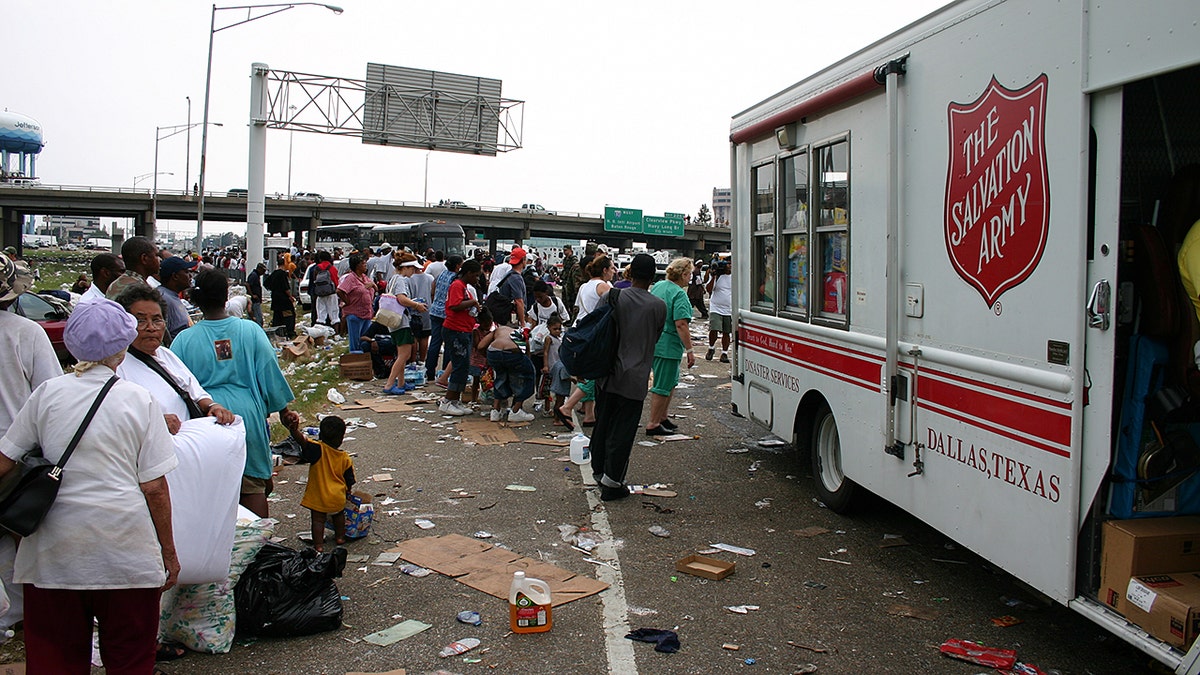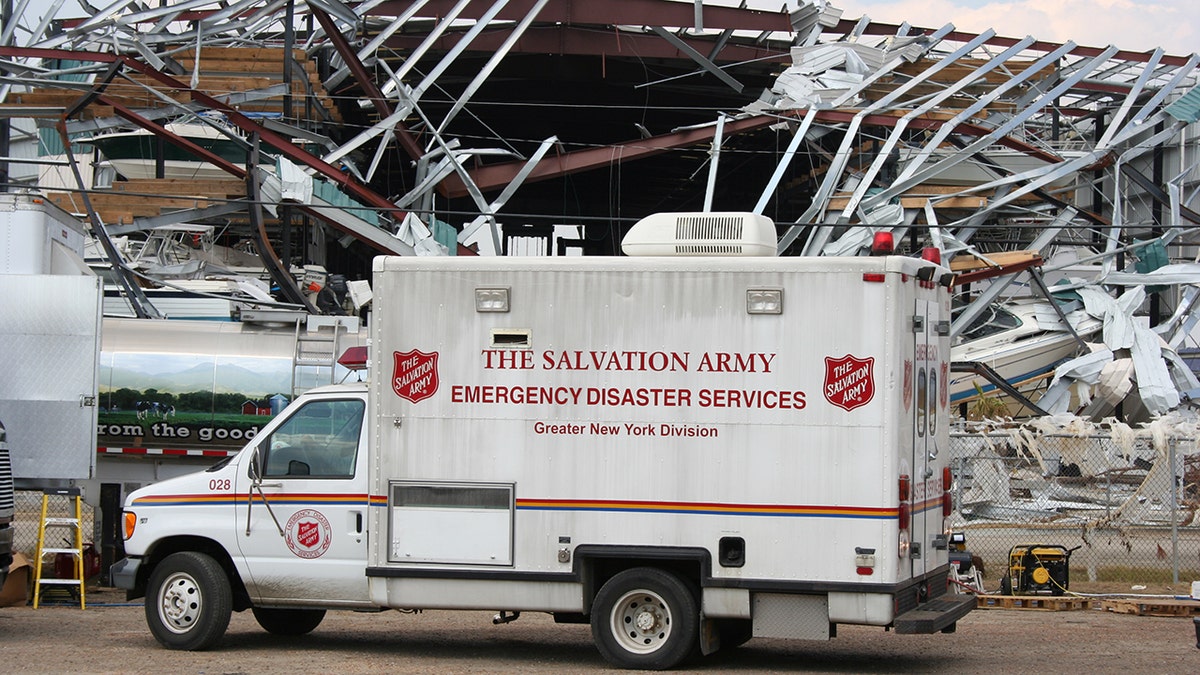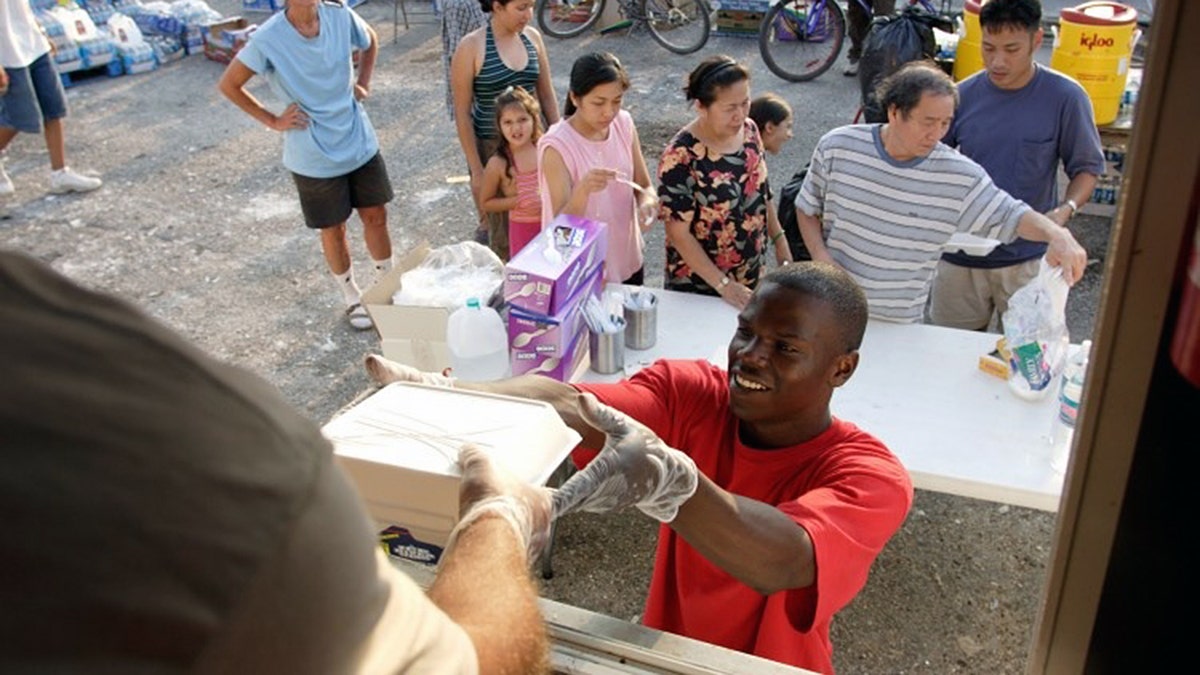Share this @internewscast.com
Two decades after Hurricane Katrina, those who lived through it and those who responded are recounting the challenges they faced and their determination to rebuild New Orleans.
“I was in the water, trying to reach my parents,” recalled Salvation Army Captain David Brittle. “But I realized God was using me to help others. Having lost nearly everything in Katrina, including a parent, I now cherish the opportunity to share my faith.”
Back in August 2005, Hurricane Katrina struck, becoming both the deadliest and most expensive storm in U.S. history. During this disaster, Brittle embarked on a two-and-a-half-day journey through flooded areas to find his parents, assisting others as well.

People impacted by Hurricane Katrina line up to receive aid from the Salvation Army in Jefferson, Louisiana in August 2005. (The Salvation Army)
When the hurricane hit, over 50 levees and flood barriers failed, flooding 80% of the city. Among the affected buildings was the Center of Hope. Despite its relatively higher ground, the storm’s force proved overwhelming.
“For it to get into the first floor of the building, that’s a lot of water,” said Captain Brittle.
Major Brittle, desperately trying to save lives at the flooding shelter, used flashing lights like Morse code to signal helicopters. Amidst the chaos, he repeatedly attempted to contact first responders via a payphone, only to be met with silence. Then, finally, a breakthrough occurred.
In a final attempt to seek assistance, he picked up the phone once more and heard a dial tone. Realizing time was of the essence, he reached out to his son.
“He said ‘Just in case something were to happen, if we don’t make it? I just want to let you know that I love you guys.’ Just when he got done speaking, the phone went dead,” said Captain Brittle, recalling the final conversation with his father.

A Salvation Army truck brought from Greater New York to assist with recovery efforts following the destruction in the Gulf Coast caused by Hurricane Katrina in August 2005. (The Salvation Army)
That call was the moment Brittle and his sister knew they had to return. As they headed to Louisiana, they stopped at Baton Rouge’s Salvation Army disaster relief post. Having grown up around his father’s colleagues, David was able to get access and join a boat crew, searching flooded neighborhoods.
“We were rescuing people as we went, getting them out of their houses,” he said.
But as more hours passed, hope began to fade.
“I did lose hope,” he admitted. “The goals we set didn’t look like they were going to happen.”
Then a call came over CB radio announcing that 300 survivors at the Center of Hope had been airlifted off the roof.
He and his sister rushed to the Cloverlead drop-off site in Metairie, where survivors were being brought by helicopter.

Volunteers with the Salvation Army provide food and aid to those impacted by the destruction from Hurricane Katrina in August 2005. (The Salvation Army)
“We found the Salvation Army canteen there,” he recalled. “I grew up around the Salvation Army, so I knew a lot of people. I just walked up to them and said, ‘Hey, have you seen Major Richard Brittle?’ And they said, ‘Yeah, they just left to go to Baton Rouge.’”
Without hesitation, Captain Brittle headed back to Baton Rouge.
“When my dad walked out, we embraced. It was the biggest hug he ever gave me. He said he loved me. I’ll never forget that moment.”
Two years later, after having contracted a parasite in the floodwaters, Major Brittle developed cancer and passed away, his son said. Brittle finds purpose in that loss.
“I don’t think I’d be an officer today if my dad were still alive,” he said. “His witness and his calling helped move me into mine.”
Reminiscing on his harrowing journey 20 years after the storm, he told Fox News Digital he found peace in the tragedy as the community was able to rebuild.
“We can take something devastating, and something beautiful can come from it,” he said. “The culture is back. The hope is back. Going through things makes you appreciate life a little more.”
That’s exactly what Meghan Foley, now the Salvation Army’s National Director of Emergency Services, saw.
Three years post-Katrina, Foley earned her teaching degree and moved to New Orleans, working at a newly opened charter school operating out of a trailer on a demolished campus.
“They’d been shuffled from school to school, and most were behind academically because the infrastructure was so broken,” she said. “They told me stories of being rescued by helicopters, and they’d just say, ‘Well, that’s what happened, Ms. Meghan.’ Like it was normal.”

A Salvation Army volunteer goes through toy donations after Hurricane Katrina decimated parts of the Gulf Coast in August 2005. (The Salvation Army)
Foley said that although these children had horrible stories to share, they still saw them positively. Foley began to understand that community resilience meant balancing the trauma of the past with the cultural joy that New Orleans brings.
She vividly remembers her first Mardi Gras with the students whose parents were part of a krewe throwing painted coconuts into the crowd. So she made a lesson plan to paint coconuts.
“I was teaching science, so the kids could decide if they wanted to decorate them based on the water cycle or the life cycle…things they were learning in the classroom,” said Foley.
As she saw her students paint those coconuts, it didn’t matter that they were in an untraditional classroom setting; they were happy celebrating the culture of New Orleans.
She says there was a juxtaposition of the storm’s trauma and the joy of the city to keep moving forward.
“Resilience isn’t just a buzzword, it’s people using joy as a tool for recovery,” Foley said. “They rely on each other. That’s what makes New Orleans unique.”

















